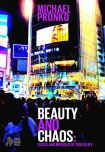Beauty and Chaos: Slices and Morsels of Tokyo Life by Michael Pronko
| Beauty and Chaos: Slices and Morsels of Tokyo Life by Michael Pronko | |
|
| |
| Category: Travel | |
| Reviewer: Rebecca Foster | |
| Summary: The pleasant and diverse travel essays in this collection draw on Pronko's 15 years living in Japan. A long-term resident but still an outsider, he is perfectly placed to notice the many odd and wonderful aspects of Tokyo life. Michael Pronko popped into Bookbag Towers to chat to us. | |
| Buy? Yes | Borrow? Yes |
| Pages: 162 | Date: November 2014 |
| Publisher: Raked Gravel Press | |
| External links: Author's website | |
| ISBN: 9781942410027 | |
| Video:
| |
Adapting a Buddhist metaphor, Michael Pronko declares that 'writing about [Tokyo] is like catching fish with a hollow gourd.' In other words, it is an elusive and contradictory place that resists easy conclusions. Anyone who has seen the Bill Murray film Lost in Translation will retain the sense of a glittering, bewildering place that Westerners wander through in a daze. A long-term resident but still a perpetual outsider, Pronko is perfectly placed to notice the many odd and wonderful aspects of Tokyo life.
The essays in this book, most of them few-page vignettes, originally appeared in Newsweek Japan, and were first collected for publication in 2006. A second volume, Tokyo's Mystery Deepens, was published in 2009. Pronko's topics are varied and surprising. He notices the kinds of things that might be taken for granted by the Japanese and overlooked entirely by visitors, such as the prevalence of vending machines and bottle displays or the popularity of store bags, loyalty cards, and truck deliveries. He takes readers to unexplored gaps, like those between properties – where cats and rubbish collect to 'create an atmosphere of loneliness.'
Most people think of Japan as an orderly, rule-driven society. Pronko acknowledges that Tokyo life is governed by timetables – 'Clocks hang everywhere and few wrists go watch-less … [people] relish a kind of cleanliness of time. Open time seems sloppy and confusing' – but also notices that the Japanese are often late or waste time. Likewise, a national obsession with maps does not equate to logical spatial arrangements: 'Tokyo is NOT a comforting city of straight, easy-to-follow lines ... Yet, on maps, the city seems to make perfect sense.'
Similarly, the Japanese are not always what they seem. It is true that they are secretive and respectful when it comes to money, and they are usually reserved in terms of physical affection. However, all that goes out the window for the month of December, when bonenkai parties dominate.
These pieces feel flowing and natural, perhaps because many arose simply from walking around, people-watching. Pronko sees a woman in head-to-toe pink and ponders how unusual the colour is in the often 'sedate' Japanese wardrobe. He delights that mobile phones have not totally replaced reading on trains. Indeed, the practice of tachi-yomi (reading standing up) proves that nothing will keep the Japanese from reading. In-your-face T-shirt slogans like 'THIS AFFECTS YOU' are another constant source of amusement.
My favourite essays were 'Singing in the Rainy Season' and 'The Love of Small Places'. Despite the inconvenience, Pronko finds theatrical beauty in days of torrential rain: 'Umbrellas turn the sidewalks into a pumping carousel of coloured half-spheres. Everyone sways like jugglers in a huge rainy parade.' The latter essay considers miniaturisation: haiku, bonsai, and interior design. Like Alain de Botton in The Architecture of Happiness, Pronko asserts that design 'shapes how one experiences the environment.' Both of these pieces (and Part Five in general) testify to Pronko's facility with visual art.
My main point of criticism is that the structure of the collection is sometimes arbitrary. Two essays that would have been helpful at the very start, 'How I Ended Up Here' and 'Japan and Me,' come later on. These give background information about Pronko growing up in Kansas City, Kansas and moving to Japan on a lark. Combined, those two essays would have made a good introduction. The piecemeal effect of magazine writing means that a few pieces feel redundant. For instance, soon after an essay on stairs, do we really need one about escalators? Also, given the subtitle, I might have expected more about Japanese cuisine.
Small quibbles aside, I recommend these poetic, whimsical essays. Pronko uses fresh metaphors, like 'Tokyo often seems like a fickle teenager, moodily swapping its clothes.' Even after 15 years in Japan, he has more questions than answers, which seems an appropriately humble attitude for an outsider to take: 'Tokyo drives me not towards well-defended conclusions, but towards open-ended musing … I read the city by writing.'
Further reading suggestion: Japan Through The Looking Glass by Alan Macfarlane is another enlightening book about Japanese culture.
Please share on: ![]() Facebook,
Facebook, ![]() Twitter and
Twitter and
![]() Instagram
Instagram
![]() You can read more book reviews or buy Beauty and Chaos: Slices and Morsels of Tokyo Life by Michael Pronko at Amazon.co.uk Amazon currently charges £2.99 for standard delivery for orders under £20, over which delivery is free.
You can read more book reviews or buy Beauty and Chaos: Slices and Morsels of Tokyo Life by Michael Pronko at Amazon.co.uk Amazon currently charges £2.99 for standard delivery for orders under £20, over which delivery is free.
![]() You can read more book reviews or buy Beauty and Chaos: Slices and Morsels of Tokyo Life by Michael Pronko at Amazon.com.
You can read more book reviews or buy Beauty and Chaos: Slices and Morsels of Tokyo Life by Michael Pronko at Amazon.com.
You can read more about Michael Pronko here.
 Michael Pronko was kind enough to be interviewed by Bookbag.
Michael Pronko was kind enough to be interviewed by Bookbag.
Comments
Like to comment on this review?
Just send us an email and we'll put the best up on the site.


